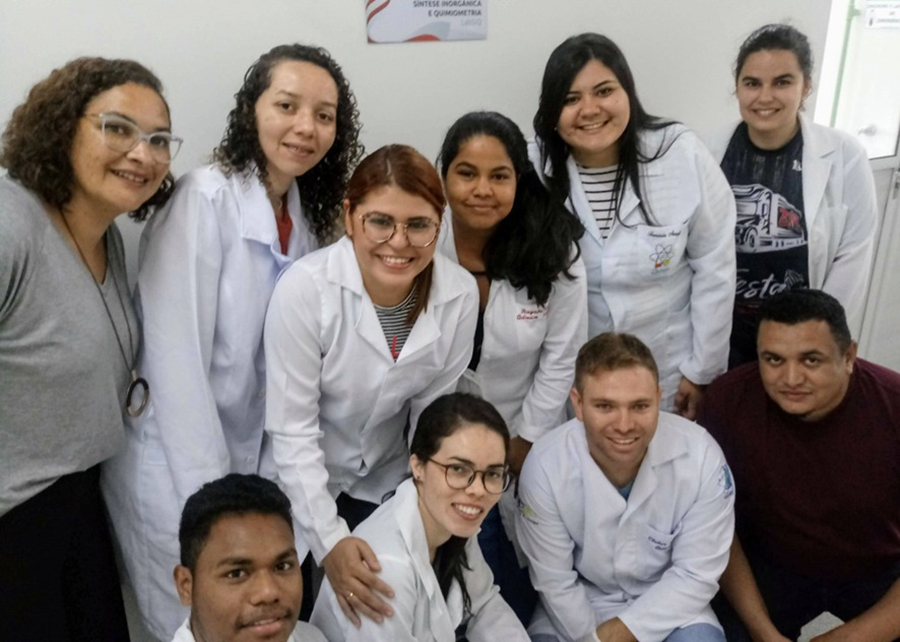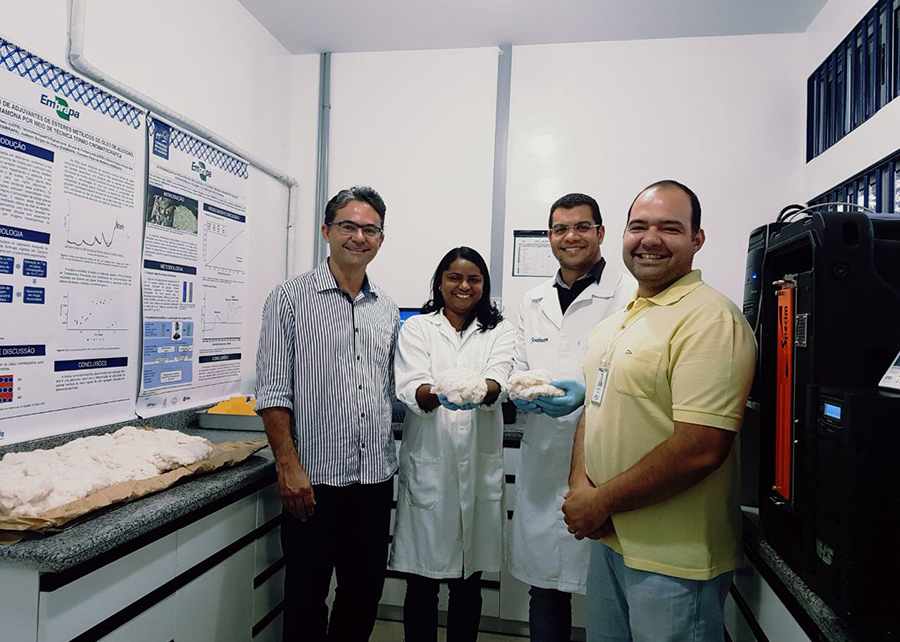The new methods involve advanced techniques based on spectroscopic images. They allow the differentiation of conventional seeds from GM ones without destroying samples. They favor quicker analyses and diagnoses in comparison with the methods used to track the plants' genetic origin. The methods do not use chemicals and do not generate waste; they are thus more sustainable. They could be associated with other methods to analyze seeds of high genetic value and verify superior traits with more precision. They are useful to analyze non-GM products aimed at organic and agroecological cultivation, for example. Researchers of the State University of Paraíba (UEPB), in partnership with teams from the Federal University of Pernambuco (UFPE), the University of Malta and Embrapa Cotton developed new methods to differentiate conventional cotton seeds from transgenic or genetically modified (GM) ones. The methods, which use techniques based on near-infrared (NIR) and Raman spectroscopies, in combination with the analysis of NIR hyperspectral images (read about the techniques further on), allow for quick, precise and low-cost diagnoses without destroying the samples. They also apply some of the principles of Green Chemistry by dispensing with chemical reagents and thus chemical waste, which results in low environmental impact and low carbon, and less water and energy use. Everaldo Medeiros, an Embrapa Cotton researcher who integrates the team responsible for the new methods, explains that molecular markers (see box below) are used to determine the traceability of genetic origin and the protection of cotton cultivars and other crops. “The methods used today for those purposes are labor-intense, expensive, long and do not preserve the samples. Moreover, in Brazil there are few laboratories that specialize in such services”, he reports. “Meanwhile, the ones that we developed are more practical and fast to phenotype materials developed by Embrapa and comprise an innovation to differentiate genetically modified products from those that are not (GMOs and non-GMOs), for example, in organic and agroecological cultivations”, he adds. Molecular Markers “A molecular marker is defined as a part of a specific DNA segment or a molecular part of an expressed gene that allows the genetic differentiation of two or more individuals.” Source: Embrapa Wheat - Online Document No. 3, Dec./00 The new methods can help advances in research strategies for fast and non-destructive phenotyping like digital markers. Initially, the main beneficiaries of such approaches are research teams, but as applications become deeper and more consolidated, the production sector and society should benefit from innovations that are easier to access and use. The researchers used a portable Raman instrument and a benchtop infrared spectrometer, as well as NIR hyperspectral imaging, hence combining new analytical methodologies. The Raman spectroscopy is based on objects' scattering of light, while the infra-red spectroscopy is based on the effects of the absorption of radiation. Meanwhile, the analysis of hyperespectral images is a technique that illustrates the chemical composition of objects through images and different digital (RGB) and spectral (visible, infrared and fluorescence) strategies. “In the future, the methods we developed could be combined to molecular markers to analyze individual seeds of high genetic value with the aim of verifying superior traits with higher precision, and perform the phenotyping, traceability and classification of different genotypes”, Medeiros anticipates. The research The studies, published in September 2021 in the specialized journalsAnalytical Methods and Spectrochimica Acta Part A: Molecular and Biomolecular Spectroscopy, were featured in scientific events - they were awarded at UEPB's Scientific Initiation Meeting and generated two Master's dissertations and papers in national and international congresses. According to one of the studies, the identification of genetically modified seeds generally requires an individual approach to the seeds. “This is due to the fact that mixing transgenic and conventional cultivars can lead to the contamination or extinction of conventional species”, the scientific paper states. The methods were applied to classify seeds of conventional cultivar BRS Aroeira and GM cultivar BRS 368 RF, both developed by Embrapa. The analysis through near infrared had a percentage error of classification of only 2.3%. Through Raman spectroscopy, there were no prediction errors. In addition to not being destructive, the methodology makes the analysis of several samples of seeds at once possible. The team The research was led by UEPB's Chemistry Graduate Program's professor Simone Simões, with the participation of Master's students Priscilla Dantas and Mayara da Mata and undergraduate students Ingrid Farias and Juliana da Silva; of the researcher from UFPE's Chemical Engineering Department and the University of Malta's Department of Nutrition and Food Science Carolina Santos Silva; and of Embrapa Cotton researcher Everaldo Medeiros. According to Simone Simões, the collaboration to develop the methods not only integrated academic knowledge and agricultural research with a focus on the production sector, but also provided the students involved with the chance to experience the applicability of what they learn at their university courses“This makes their professional training more complete, and such qualified training of human resources in advanced areas of science can be adopted by companies and research centers”, she assesses. The student Priscilla Dantas states that participating in the study helped her understand what scientific research is like and be proud to be a scientist. “The process was simultaneously pleasant and intimidating, as it combined elements with which few people have the opportunity to have contact both from a technological and from a content standpoint. Not every company or university has access to such advanced equipment, especially the hyperspectral-imaging spectrometer”, she observes.
-
The new methods involve advanced techniques based on spectroscopic images. -
They allow the differentiation of conventional seeds from GM ones without destroying samples. -
They favor quicker analyses and diagnoses in comparison with the methods used to track the plants' genetic origin. -
The methods do not use chemicals and do not generate waste; they are thus more sustainable. -
They could be associated with other methods to analyze seeds of high genetic value and verify superior traits with more precision. -
They are useful to analyze non-GM products aimed at organic and agroecological cultivation, for example. |
Researchers of the State University of Paraíba (UEPB), in partnership with teams from the Federal University of Pernambuco (UFPE), the University of Malta and Embrapa Cotton developed new methods to differentiate conventional cotton seeds from transgenic or genetically modified (GM) ones.
The methods, which use techniques based on near-infrared (NIR) and Raman spectroscopies, in combination with the analysis of NIR hyperspectral images (read about the techniques further on), allow for quick, precise and low-cost diagnoses without destroying the samples.
They also apply some of the principles of Green Chemistry by dispensing with chemical reagents and thus chemical waste, which results in low environmental impact and low carbon, and less water and energy use.
Everaldo Medeiros, an Embrapa Cotton researcher who integrates the team responsible for the new methods, explains that molecular markers (see box below) are used to determine the traceability of genetic origin and the protection of cotton cultivars and other crops.
“The methods used today for those purposes are labor-intense, expensive, long and do not preserve the samples. Moreover, in Brazil there are few laboratories that specialize in such services”, he reports. “Meanwhile, the ones that we developed are more practical and fast to phenotype materials developed by Embrapa and comprise an innovation to differentiate genetically modified products from those that are not (GMOs and non-GMOs), for example, in organic and agroecological cultivations”, he adds.
Molecular Markers “A molecular marker is defined as a part of a specific DNA segment or a molecular part of an expressed gene that allows the genetic differentiation of two or more individuals.” Source: Embrapa Wheat - Online Document No. 3, Dec./00 |
The new methods can help advances in research strategies for fast and non-destructive phenotyping like digital markers. Initially, the main beneficiaries of such approaches are research teams, but as applications become deeper and more consolidated, the production sector and society should benefit from innovations that are easier to access and use.
The researchers used a portable Raman instrument and a benchtop infrared spectrometer, as well as NIR hyperspectral imaging, hence combining new analytical methodologies. The Raman spectroscopy is based on objects' scattering of light, while the infra-red spectroscopy is based on the effects of the absorption of radiation. Meanwhile, the analysis of hyperespectral images is a technique that illustrates the chemical composition of objects through images and different digital (RGB) and spectral (visible, infrared and fluorescence) strategies.

“In the future, the methods we developed could be combined to molecular markers to analyze individual seeds of high genetic value with the aim of verifying superior traits with higher precision, and perform the phenotyping, traceability and classification of different genotypes”, Medeiros anticipates.
 The research
The research
The studies, published in September 2021 in the specialized journalsAnalytical Methods and Spectrochimica Acta Part A: Molecular and Biomolecular Spectroscopy, were featured in scientific events - they were awarded at UEPB's Scientific Initiation Meeting and generated two Master's dissertations and papers in national and international congresses.
According to one of the studies, the identification of genetically modified seeds generally requires an individual approach to the seeds. “This is due to the fact that mixing transgenic and conventional cultivars can lead to the contamination or extinction of conventional species”, the scientific paper states.
The methods were applied to classify seeds of conventional cultivar BRS Aroeira and GM cultivar BRS 368 RF, both developed by Embrapa. The analysis through near infrared had a percentage error of classification of only 2.3%. Through Raman spectroscopy, there were no prediction errors. In addition to not being destructive, the methodology makes the analysis of several samples of seeds at once possible.
 The team The team
The research was led by UEPB's Chemistry Graduate Program's professor Simone Simões, with the participation of Master's students Priscilla Dantas and Mayara da Mata and undergraduate students Ingrid Farias and Juliana da Silva; of the researcher from UFPE's Chemical Engineering Department and the University of Malta's Department of Nutrition and Food Science Carolina Santos Silva; and of Embrapa Cotton researcher Everaldo Medeiros. According to Simone Simões, the collaboration to develop the methods not only integrated academic knowledge and agricultural research with a focus on the production sector, but also provided the students involved with the chance to experience the applicability of what they learn at their university courses “This makes their professional training more complete, and such qualified training of human resources in advanced areas of science can be adopted by companies and research centers”, she assesses. “This makes their professional training more complete, and such qualified training of human resources in advanced areas of science can be adopted by companies and research centers”, she assesses. The student Priscilla Dantas states that participating in the study helped her understand what scientific research is like and be proud to be a scientist. “The process was simultaneously pleasant and intimidating, as it combined elements with which few people have the opportunity to have contact both from a technological and from a content standpoint. Not every company or university has access to such advanced equipment, especially the hyperspectral-imaging spectrometer”, she observes. |

